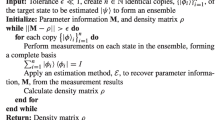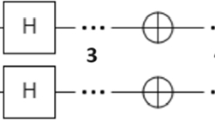Abstract
Quantum-dot cellular automata (QCA) is a field coupling nano-technology that has drawn significant attention for its low power consumption, low area overhead, and achieving a high speed over the CMOS technology. Majority Voter (MV) and QCA Inverter (INV) are the primitive logic in QCA for implementing any QCA circuit. The performance and cost of a QCA circuit directly depend on the number of QCA primitives and their interconnections. Their optimization plays a crucial role in optimizing the QCA logic circuit synthesis. None of the previous works considered elitism in GA, all the optimization objectives (MV, INV and Level), and the redundancy elimination approach. These profound issues lead us to propose a new methodology based on Genetic algorithm (GA) for the cost-effective synthesis of the QCA circuit of the multi-output boolean functions with an arbitrary number of inputs. The proposed method reduces the delay and gate count, where the worst-case delay is minimized in terms of the level. This methodology adapts elitism to preserve the best solutions throughout the intermediate generations. Here, MV, INV, and levels are optimized according to their relative cost factor in a QCA circuit. Moreover, new methodologies are proposed to create the initial population, maintain the variations, and eliminate redundant gates. Simulation results endorse the superiority of the proposed method.






Similar content being viewed by others
Data Availability
The authors declare that the data supporting the findings of this study are available within the article.
References
Abraham A, Jain L (2005) Evolutionary multiobjective optimization. Evolutionary Multiobjective Optimization pp 1–6
Ahmadpour SS, Mosleh M (2021) Ultra-efficient adders and even parity generators in nano scale. Comput Electr Eng 96:107548
Ahmadpour SS, Mosleh M, Heikalabad SR (2020) The design and implementation of a robust single-layer qca alu using a novel fault-tolerant three-input majority gate. J Supercomput 76:10155–10185
Ahmadpour SS, Mosleh M, Asadi MA (2021) The development of an efficient 2-to-4 decoder in quantum-dot cellular automata. Iran J Sci Technol Trans Electr Eng 45:391–405
Ahmadpour SS, Mosleh M, Heikalabad SR (2022) Efficient designs of quantum-dot cellular automata multiplexer and ram with physical proof along with power analysis. J Supercomput 78:1672–1695
Ahn CW, Ramakrishna RS (2003) Elitism-based compact genetic algorithms. IEEE Trans Evolut Comput 7(4):367–385. https://doi.org/10.1109/TEVC.2003.814633
Bhanja S, Ottavi M, Lombardi F, Pontarelli S (2006) Novel designs for thermally robust coplanar crossing in qca. In: 2006 Design, Automation and Test in Europe, IEEE Computer Society, vol 1, pp 6
Bonyadi MR, Azghadi SMR, Rad NM, Navi K, Afjei E (2007) Logic optimization for majority gate-based nanoelectronic circuits based on genetic algorithm. In: 2007 International Conference on Electrical Engineering, pp 1–5, https://doi.org/10.1109/ICEE.2007.4287307
Campos CAT, Marciano AL, Neto OPV, Torres FS (2015) Use: a universal, scalable, and efficient clocking scheme for qca. IEEE Trans Comput-Aided Des Integr Circuits Syst 35(3):513–517
Changdar C, Mahapatra G, Pal RK (2014) An efficient genetic algorithm for multi-objective solid travelling salesman problem under fuzziness. Swarm Evolut Comput 15:27–37. https://doi.org/10.1016/j.swevo.2013.11.001
Chu PC, Beasley JE (1997) A genetic algorithm for the generalised assignment problem. Comput Operations Res 24(1):17–23
Coello CAC, Lamont GB, Van Veldhuizen DA et al (2007) Evolutionary algorithms for solving multi-objective problems, vol 5. Springer, Berlin
Deb K (2015) Multi-Objective Evolutionary Algorithms, Springer Berlin Heidelberg, Berlin, Heidelberg, pp 995–1015. doi: https://doi.org/10.1007/978-3-662-43505-2_49
Dysart TJ, Kogge PM (2007) Probabilistic analysis of a molecular quantum-dot cellular automata adder. In: 22nd IEEE International Symposium on Defect and Fault-Tolerance in VLSI Systems (DFT 2007), IEEE, pp 478–486
Goswami M, Mondal A, Mahalat MH, Sen B, Sikdar BK (2019) An efficient clocking scheme for quantum-dot cellular automata. Int J Electron Lett pp 1–14
Gunter AK (2019) Design and investigation of genetic algorithmic and reinforcement learning approaches to wire crossing reductions for pnml devices
Hen CK (2011) Design and development of automated digital circuit structure base on evolutionary algorithm method. Int J Electron Comput Commun Technol 2(1):1–8
Hennessy K, Lent CS (2001) Clocking of molecular quantum-dot cellular automata. J Vac Sci Technol B Microelectron Nanometer Struct Process Meas Phenomena 19(5):1752–1755
Houshmand M, Khayat SH, Rezaei R (2009) Genetic algorithm based logic optimization for multi- output majority gate-based nano-electronic circuits. In: 2009 IEEE International Conference on Intelligent Computing and Intelligent Systems, vol 1, pp 584–588, doi: https://doi.org/10.1109/ICICISYS.2009.5357775
Houshmand M, Saleh RR, Houshmand M (2011) Logic Minimization of QCA Circuits Using Genetic Algorithms, Springer Berlin Heidelberg, Berlin, Heidelberg, pp 393–403. doi: https://doi.org/10.1007/978-3-642-20505-7_35
Jong KAD, Spears WM (1989) Using genetic algorithms to solve np-complete problems
khosroshahy MB, Daliri MS, Abdoli A, Navi K, Bagherzadeh N (2016) A 3d universal structure based on molecular-qca and cnt technologies. J Mol Struct pp 86–95
Khosroshahy MB, Moaiyeri MH, Angizi S, Bagherzadeh N, Navi K (2017) Quantum-dot cellular automata circuits with reduced external fixed inputs. Microprocess Microsyst 50:154–163
Konak A, Coit DW, Smith AE (2006) Multi-objective optimization using genetic algorithms: a tutorial. Reliab Eng Syst Safe 91(9):992–1007
Kong K, Shang Y, Lu R (2010) An optimized majority logic synthesis methodology for quantum-dot cellular automata. IEEE Trans Nanotechnol 9(2):170–183. https://doi.org/10.1109/TNANO.2009.2028609
Lent CS, Tougaw PD (1997) A device architecture for computing with quantum dots. In: Proceedings of the IEEE
Lent CS, Tougaw PD, Porod W, Bernstein GH (1993) Quantum cellular automata. Nanotechnology 4(1):49
Liu P, Ni J, Chu Z (2022) Wire-crossings optimization based on majority-of-five and xor-of-three primitives in qca. Int J Theor Phys 61(3):1–22
Machado RS, Castellanos J, Lahoz-Beltra R (2016) Evolutionary synthesis of qca circuits: a critique of evolutionary search methods based on the hamming oracle. Int J Inf Technol Knowl 10(3):203–215
Neto OPV, Pacheco MAC, Barbosa CRH (2007) Neural network simulation and evolutionary synthesis of qca circuits. IEEE Trans Comput 56(2):191–201
Orlov A, Amlani I, Bernstein G, Lent C, Snider G (1997) Realization of a functional cell for quantum-dot cellular automata. Science 277(5328):928–930
Pal J, Bhattacharjee S, Saha AK, Dutta P (2019) Study on temperature stability and fault tolerance of adder in quantum-dot cellular automata. In: 2019 5th International Conference on Signal Processing, Computing and Control (ispcc), IEEE, pp 69–74
Potvin JY (1996) Genetic algorithms for the traveling salesman problem. Ann Operations Res 63(3):337–370
Rezaee R, Houshmand M, Houshmand M (2013) Multi-objective optimization of qca circuits with multiple outputs using genetic programming. Genet Program Evol Mach 14(1):95–118. https://doi.org/10.1007/s10710-012-9173-6
Roohi A, Menbari B, Shahbazi E, Kamrani M (2013) A genetic algorithm based logic optimization for majority gate-based qca circuits in nanoelectronics. Quant Matter 2(3):219–224
Roohi A, Thapliyal H, DeMara R (2015) Wire crossing constrained qca circuit design using bilayer logic decomposition. Electron Lett 51(21):1677–1679
Sarvaghad-Moghaddam M, Orouji AA, Houshmand M (2017) A multi-objective synthesis methodology for majority/minority logic networks. J Comput Electron 16(1):162–179. https://doi.org/10.1007/s10825-016-0938-7
Sastry K, Goldberg DE, Kendall G (2014) Genetic Algorithms, Springer US, Boston, MA, pp 93–117. doi: https://doi.org/10.1007/978-1-4614-6940-7_4
Sridharan K, Pudi V (2015) Design of arithmetic circuits in quantum dot cellular automata nanotechnology, vol 599. Springer, Berlin
Tehrani MA, Navi K, Kia-kojoori A (2013) Multi-output majority gate-based design optimization by using evolutionary algorithm. Swarm Evolut Comput 10:25–30. https://doi.org/10.1016/j.swevo.2012.12.002
Tougaw PD, Lent CS (1994) Logical devices implemented using quantum cellular automata. J Appl phys 75(3):1818–1825
Vasicek Z, Sekanina L (2016) Evolutionary design of complex approximate combinational circuits. Genet Program Evol Mach 17(2):169–192. https://doi.org/10.1007/s10710-015-9257-1
Vijayakumari C, Mythili P, James RK, Kumar CA (2015) Genetic algorithm based design of combinational logic circuits using universal logic modules. Procedia Comput Sci 46:1246–1253
Walus K, Schulhof G, Jullien GA, Zhang R, Wang W (2004) Circuit design based on majority gates for applications with quantum-dot cellular automata. In: Conference Record of the Thirty-Eighth Asilomar Conference on Signals, Systems and Computers, 2004., vol 2, pp 1354–1357 Vol.2, doi: https://doi.org/10.1109/ACSSC.2004.1399374
Whitley D (1994) A genetic algorithm tutorial. Stat Comput 4(2):65–85
Zhang R, Walus K, Wang W, Jullien GA (2004) A method of majority logic reduction for quantum cellular automata. IEEE Trans Nanotechnol 3(4):443–450
Acknowledgements
This work is sponsored by the Young Faculty Research Fellowship (YFRF) of Visvesvaraya Ph.D. scheme through the grant number MLA/MUM/GA/ 10(37)B.
Author information
Authors and Affiliations
Corresponding author
Ethics declarations
Conflict of interest
The authors declare that they have no conflict of interest.
Additional information
Publisher's Note
Springer Nature remains neutral with regard to jurisdictional claims in published maps and institutional affiliations.
Rights and permissions
Springer Nature or its licensor holds exclusive rights to this article under a publishing agreement with the author(s) or other rightsholder(s); author self-archiving of the accepted manuscript version of this article is solely governed by the terms of such publishing agreement and applicable law.
About this article
Cite this article
Pramanik, A.K., Mahalat, M.H., Pal, J. et al. Cost-effective synthesis of QCA logic circuit using genetic algorithm. J Supercomput 79, 3850–3877 (2023). https://doi.org/10.1007/s11227-022-04757-0
Accepted:
Published:
Issue Date:
DOI: https://doi.org/10.1007/s11227-022-04757-0




